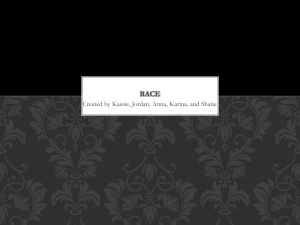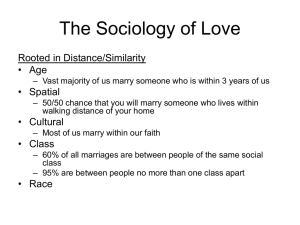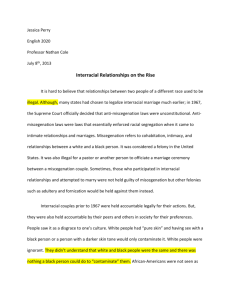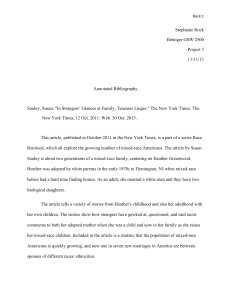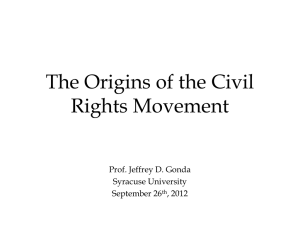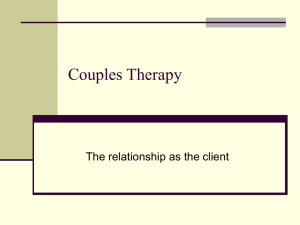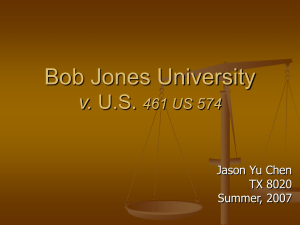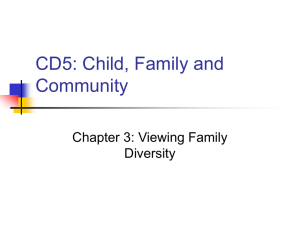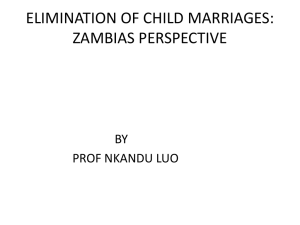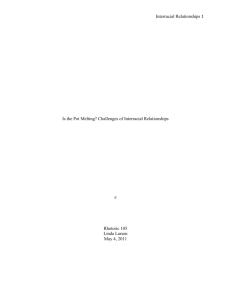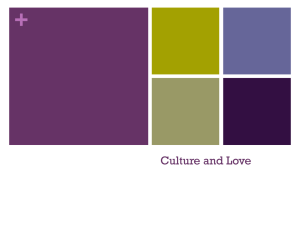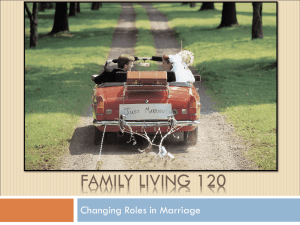Interracial Relationships RUNNING HEAD: Interracial Relationships
advertisement
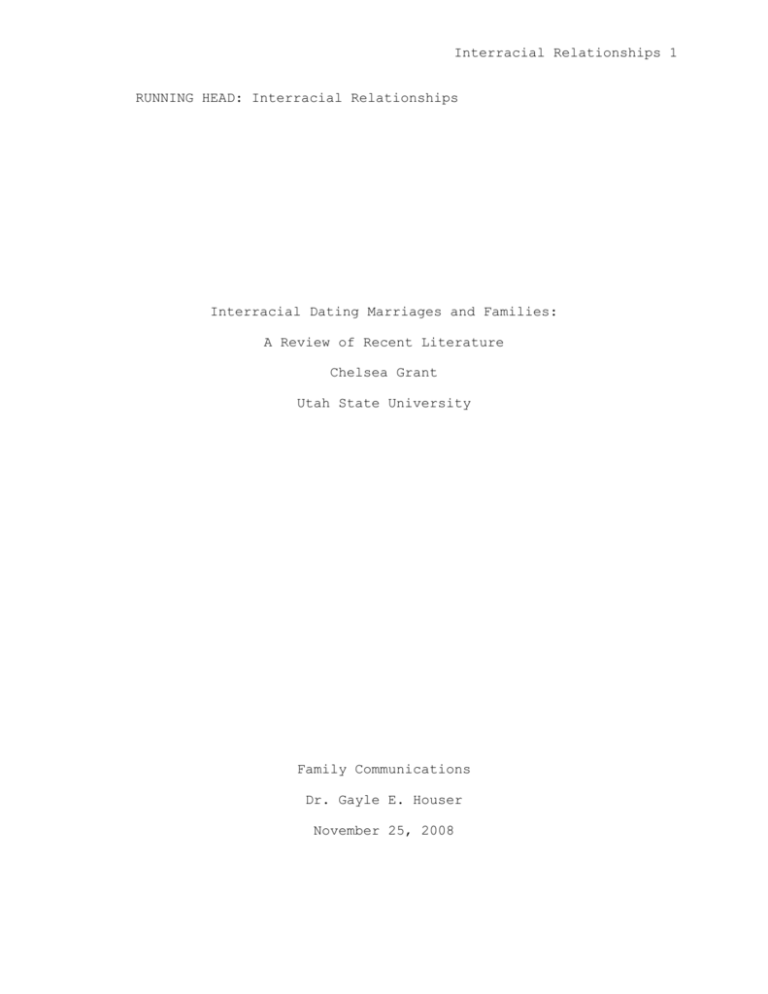
Interracial Relationships 1 RUNNING HEAD: Interracial Relationships Interracial Dating Marriages and Families: A Review of Recent Literature Chelsea Grant Utah State University Family Communications Dr. Gayle E. Houser November 25, 2008 Interracial Relationships 2 Abstract The purpose of this literary review is to explore the research that has been done on interracial relationships and the different conflicts those involved with these relationships experience. I primarily focused on the relationships between African Americans and Non-Hispanic white, as members of these relationships experience the most controversy from society and family. This paper demonstrates the outside and inside influences that affect an interracial couple and their chances of creating a successful family as well as who approves of/ and is more likely to participate in interracial relationships. Interracial Relationships 3 Introduction In the 2005 release of Guess Who, Ashton Kutcher and Bernie Mac star in a motion picture depicting a white male (Kutcher) attempting to marry an African American woman. The movie demonstrates the prejudices and challenges the couple has when presented with societies disapproval and the discontentment from the bride-to-be’s family, particularly the dad. Kutcher’s character struggles to win the approval of the family he hopes to soon call his in-laws. And his in-laws struggle to show their daughter they are happy for her and excited that she has found such a wonderful guy, despite the fact that he is a white boy. This film is not based on a true story. However, is realistic depiction of the struggles that interracial couples must face when confronting family and society with an open relationship? A Growing Number of Interracial Relationships and the Younger Generation On June 12, 1967, the U.S. Supreme Court eradicated all laws banning interracial marriages and in 1970 less than one percent of all marriages were interracial. Since then, interracial marriages have Interracial Relationships 4 grown substantially more common (Bratter, King, 2008). In 2000, six percent of all marriages were interracial according to the U.S. Census Bureau. The growing number of interracial marriages could be linked to the rising generation of young adults that show a greater acceptance of interracial dating and relationships. According to Golebiowaska (2007), there is a significant generational gap in opposition to black-white intermarriage and thus the future shows hope for much less racial hostility toward these couples, than that of their grandparents. The younger generation is much more likely to have friends from a different race or cultural background, and thus more likely to interracially date (Richardson, 2008). Although parents may disapprove of interracial dating, the younger generation values freethinking and individualism above their parents or grandparents old ways of thinking. In a survey done at Bob Jones University – a school deeply rooted in Southern values and traditions- most students believe that if their parents do not approve of them crossing racial lines in their relationships, they are being racist (Firmin, Firebaugh, 2008), a drastic change from their grandparents. In “The New Face of America,” as cited by McFadden (2001), Passel and Edmonton predict that by the year 2050 the percentage of the U.S. population that will have mixed ancestry (any combination white, Hispanic, Asian, or black) will triple to 21 percent. Interracial marriages are predicted to continually increase (McFadden, 2001), Interracial Relationships 5 despite the data supporting the fact that interracial marriages are more vulnerable to failure (Bratter, King 2008). Divorce in Interracial Marriages As cited by Bratter and King (2008), Bramlet and Mosher (2002) found that 41 percent of interracial couples were divorced by their tenth year of marriage, contrasted with 31 percent of same-race marriages which were divorced. Other studies on the subject have found similar results, that interracial marriage, particularly among black/white couples, are more likely to divorce then those of samerace marriages (Bratter, et al.). Interracial relationships are uniquely related to divorce rates. They can be inflicted by differences in cultures, language barriers, world views, values, expected gender roles, and/or conflicting ideas on properly raising and teaching children (Troy, Lewis-Smith, Lauenceau, 2006). If the members of interracial marriages feel a weak sense of racial identity, they are more likely to feel insecure about their marriage (Leslie, Letiecq, 2004). Racial identity is the extent that an individual is aware of, understands and values their cultural background. When a person feels confident in their culture’s history and is proud of their race they are more likely to accept those from outside races. With confidence in their own race and understanding of their partners race, members of interracial marriages that have a Interracial Relationships 6 strong sense of racial identity are far more likely to succeed in the marriage (Leslie, ibid). Another factor that plays a critical role in the higher divorce rates of intermarriages is the pressures by inner and outer networks of society. Crossing racial lines can bring pressure from both society and the FOO. Bratter and King (2008, p. 163) say that “of all the ways individuals can form families across ascribed social boundaries, crossing racial lines is the most controversial with contemporary American society. Race stratifies physical, mental, and economic well being and is a primary component of individual and family identity.” Societies Racism and Inner Network Pressure Richardson (2008) quotes Renee Romano (author of Race Mixing: Black-White Marriage in Postwar America) stating, “probably the biggest single reason that intermarriage rate has been low is because America remains in many ways a segregated society.” In an issue of Christianity Today, Harold (1944) tells a story of the important relationship of intermarriage and racism. “Nothing brings out our bidden, forgotten prejudices like interracial marriage. Shortly before Martin Luther King, Jr. was killed, he wrote about a woman who said to him that she had no prejudices: “I believe Negroes should have the right to vote, the right to a good job, the right to a decent home, and the right to have access to public accommodations. Of course, I must confess that I would not want my daughter to marry a Negro.” King correctly pointed out that the woman’s failure to accept Interracial Relationships 7 interracial marriage negated her claims. “The question of intermarriage is never raised in a society cured of the disease of racism.” (Harold, 1994)” Even today interracial couples face social pressures unknown to intraracial couples, such as: stares from others, stereotypes, family opposition, and mistreatment by restaurant staff, real estate agents, retail clerks, hotel managers and coworkers (Troy, Lewis-Smith, Laurenceau, 2006). Sixty-four percent of Black/White couples experience negative public reaction. Interracial couples have to deal with racism two-fold. For example, a black may be discriminated against because of his race by members of a different race, then, as he takes a white wife, he may experience racism from members of his own race (Leslie, Letiecq, 2004). Community support is a strong predictor of the level of commitment in a given relationship. If a couple is shown a lack of support from close friends and family, it will more than likely adversely impact positive functioning within the relationship (Troy, Lewis-Smith, Laurenceau, 2006). In a study done by Golebiowska (2007), he found that among a population of non-Hispanic whites, only 23 percent would embrace or strongly embrace an interracial marriage between an African American and a close member of their family. Slightly over 37 percent would oppose or strongly oppose the union, and the rest felt they would neither oppose nor embrace. Who Interracially Dates and/or Marries? Interracial Relationships 8 Two articles by Merton (1941) and Davis (1941) as cited by Gullickson (2006), introduce a highly influential theory, called the status exchange theory, which argues that the reason blacks and whites intermarry is to gain a higher social standing. For example, a highly educated black man will marry a white wife, trading his educational status for her racial status. It also works in reverse; an uneducated white female would trade her racial status in order to gain a higher educational status. This theory has been proven wrong by a number of different tests, because most interracial marriages, like intraracial marriages, are strongly correlated with similar class and education levels (Gullickson, ibid). “Members of different groups that have sufficiently reduced social distance between each other can easily enter into dating/marital relationships. An assessment of who is willing to engage in interracial relationships is important for evaluating who tends to support cross-racial social interactions,” Yancey, 2007, p. 197. As previously mentioned there is a strong correlation between openness to interracial relationships and marriage with the younger age group, particularly in a college campus atmosphere (Gullickson, 2006). “Aside from its “liberating” influence, the college campus might also have an effect on interracial unions simply by providing a local marriage market, where blacks and whites are unusually integrated (Gullickson, 2006, p. 291).” Interracial Relationships 9 Besides young age, there is also a strong correlation between acceptance of interracial couples and education level (Gullickson, ibid). In a study done by Jacobson and Johnson (2006), they showed that the odds of approval among those with a high school education or higher were 19 percent higher than for those with less than a high school education. They also found that those with higher income levels, black males, less religious individuals and those living in a metropolitan area, where they are exposed to a wider variety of cultures, were more likely to be open and approve of interracial marriages. They further went on to explore the relationship between having friends of a different race and acceptance of interracial marriages. This was the strongest correlation. They found that when individuals reported having close friends of another race they were significantly more likely to approve of intermarriage. According to the U.S. Census Bureau statistics in 2000, 570,919 black/white marriages existed in the United States. Of those only 116,000 were between white men and black women. Black men are twice as likely to date, marry and cohabitate with women of a different or culture than Black women (Henderson, 2007). Most studies have found that the overall African American race is more open to intermarriage (85 percent) than whites (Jacobson, Johnson, 2006). However a study, done by Todd and Mckinney (1992) as cited by Firmin and Firebaugh (2008), which surveyed 400 people in an integrated local California community showed that younger people were more open than older, men were more agreeable than women (similar to Interracial Relationships 10 the previously cited studies), but they found that Caucasians were slightly more open to interracial relationships. This finding was congruent with several other studies cited in the literature review. Within the Interracial Family Other than all the struggles of racism and societal pressure, interracial families must also overcome the difficulty of watching their spouse and/or children be discriminated against. John McFadden (2001) says children of interracial parents will commonly experience the social isolation that comes with not belonging to a defined group. Therefore it is crucial for the parents to install in them a strong sense of confidence, and help them adjust to being labeled as “others.” Interracial marriages between and African American are generally met with the most hostility, so individuals in these marriages must be prepared to face the emotional difficulties when watching their spouse be shown discrimination. Yancey (2007) researched and interviewed various interracial married couples, in-depth. On a particular interview a white woman told of a time she left a bar with her husband and shortly after driving out of the parking lot, was pulled over by a police officer. The police officer asked her to get out of the car while her husband remained in the drivers seat. The officer then proceeded to ask her if she was ok, and if she was safe, insinuating that this man intended on taking advantage of her. The woman went on to tell of how upset she was, as she yelled that that man was her husband. Yancey reported that all participants felt that since their Interracial Relationships 11 marriage, their views on both their race and their spouse’s race changed substantially. Individuals in interracial marriages have also reported a greater sense of unity. The outside stereotypes and racist views will often cause the family to present a united front, to prove that they do belong together and they can make it work (Leslie, Letecq, 2004). Individuals have also reported other advantages such as learning about new activities and cultures and expanding their cultural perspective (Troy, Lewis-Smith, Laurenceau, 2006). In the a study by Troy, Lewis-Smith, and Laurenceau (2006), they found that interracial partners reported higher relationship satisfaction than same-race couples– contrary to their hypothesis- and similar conflict patterns and attachment styles. “On entering intermarital relationships, both the individual and family members of origin experience varying phases of adjustment,” McFadden, 2001, p. 40. Family members must “respectfully attain a level of cultural transcendency that complements the maintenance of positive marital relationship. It is through parents, children, family, and confidantes that racial divide is minimized and intermarriages are maximized,” McFadden, ibid. Conclusion Interracial marriages face a number of unique challenges that samerace marriages don’t have to worry about. Marriage is difficult under the most favorable circumstances, adding the complication of racial Interracial Relationships 12 and cultural differences along with societal pressures can only increase the vulnerability of the marriage. Because of these additional challenges, the divorce rates are higher for interracial couples, but that doesn’t mean that there aren’t a number of happy and successful interracial marriages across the world. It seems obvious through the literature reviewed that as the number of interracial marriages goes up, discrimination will be greatly reduced and the global acceptance will continue to rise. With the recent election of an African American to the President of the United States, it is clear the racism is indeed depleting. Perhaps somewhere in the near future America will view marriages crossing any racial boundary as equal to any other. Until then I’m sure the devoted interracial couples will continue to fight against the biases and challenges they face to create and maintain a happy relationship. Interracial Relationships 13 References Bratter, J.L., King, R.B. (2008). "But will it last?": Marital instability among interracial and same-race couples. Interdisciplinary Journal of Applied Family Studies, 57(2), 160171. Firmin, M.W., Firebaugh, S. (2008). Historical analysis of college campus interracial dating. College Student Journal, 42(3), 782788. Golebiowska, E.A. (2007). The contours of etiology of whites' attitudes toward black-white interracial marriage 1. Journal of Black Studies, 38(2), 268-287. Gullickson, A. (2006). Black/White interracial marriage trends, 1850- 2000. Journal of Family History, 31(3), 289-312. Gullickson, A. (2006). Education and black-white interracial marriage. Demography, 43(4), 673-689. Harold, M. (1994, March, 7). Love in black and white. Christianity Today, 38, 18. Henderson, S. (2007, March). Is love becoming color blind? Ebony, 62, 147. Jacobsen, C. K., Johnson, B.R. (2006). Interracial friendship and African American attitudes about interracial marriage. Journal of Black Studies, 36(4), 570-584. Kristof, N.D. (2005, April 24). Blacks, whites and love. The New York Times, p. 13. Leslie, L. A., Letiecq, B.L. (2004). Marital quality of African American and white partners in interracial couples. Relationships, 11(4), 559-574. Personal Interracial Relationships 14 McFadden, J. (2001). Intercultural marriage and family: Beyond the racial divide. The Family Journal, 9(1), 39-42. Norment, L. (2006, April). The multiple colors of love. Ebony, 53, 36. Richardson, N. M. (2008, June). Mixed marriage. Black Enterprise, 38, 40. Topping, J., Stoff, E., Goldberg, J. (Producers), & Sullivan, K.R. (Director). (2005, March 25). Guess Who [Motion picture]. United States: Sony Pictures. Troy, A. T., Lewis-Smith, J., Laurenceau, J. P. (2006). Interracial and intraracial romantic relationships: The search for differences in satisfaction, conflict, and attachment style. Journal of Social and Personal Relationships, 23(1), 65-80. Yancey, G. (2007). Experiencing Racism: Differences in the experiences of whites married to blacks and non-black racial minorities. Journal of Comparative Family Studies, 38(2), 197-213. Yancey, G. (2002). Who interracially dates: An examination of characteristics of those who have interracially dated. Journal of Comparative Family Studies, 33(2), 179-190.
